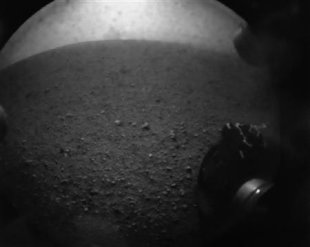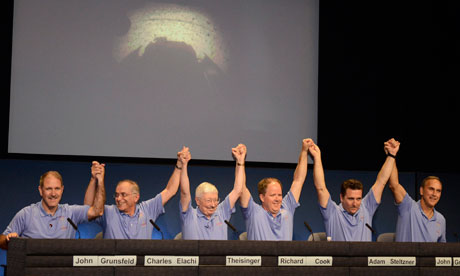Space junkies try to explain mysterious image in photo from Mars rover
A mysterious blotch that appeared along the horizon in a photo from the surface of Mars stirred speculation about what it might be, as two hours later it was gone.
One theory put forth by space enthusiasts in the L.A. Times story is that Curiosity had somehow snapped a photo of part of the spacecraft that escorted the rover through the Martian atmosphere crash-landing a distance away.
|  |
Pentagon helps build Meshworm reconnaissance robot
Engineers have created a robot that mimics a worm's movements - crawling along surfaces by contracting segments of its body.
The technique allows the machine to be made of soft materials so it can squeeze through tight spaces and mould its shape to rough terrain. It can also absorb heavy blows without sustaining damage. |  |
Weird weather rains seaweed over Gloucestershire village
They were stunned to find their homes, gardens and cars littered with the smelly marine algae after a stormy weather spout swept up the debris from a beach 20 miles away.
Weather experts believe the seaweed was picked up from Clevedon Beach in North Somerset by a twister during freak weather conditions on the coast. It was then carried through the air - before being deposited on the quiet street in Berkeley, near Cheltenham, Glos. Stunned engineer Dr Richard Overton, 55, and his wife Kay, collected an entire bucket full of the green slime from their front garden. |  |
Can a reality TV show help put humans on Mars?
On 5 and 6 June earthlings gathered to watch Venus cross the face of the sun. We won't have that opportunity again until 2117, but on 10 November 2084 something even more wonderful will be on offer. The Earth will transit across the sun – for observers on Mars, that is. This time the valiant speck rowing across the solar disc will be us. Will anyone be there on Mars to see it?
Fifty years ago, the answer would have been a confident yes; some even hoped we'd get there in time to view the last Earth transit, in 1984. Then the possibility dwindled as Nasa turned away from manned space travel towards robotic landers such as Curiosity. |  |
Golden Mummies: What Happened To The Indiana Jones Of Egypt?

Zahi Hawass’ ego hasn’t suffered since protesters forced him out of his influential post as Egypt’s antiquities steward 18 months ago, shortly after Hosni Mubarak was toppled from the country’s presidency.
“I am Egyptian antiquities,” he says.
That confidence served him well when he controlled the pharaohs’ treasures on Mubarak’s behalf, steering Egypt’s economically critical Supreme Council of Antiquities and the billions it helped reap annually, primarily from tourism and international exhibitions. The man who calls himself Egypt’s Indiana Jones has fewer friends these days, now that revolution and a corruption scandal have forced him from office. Protesters who picketed Hawass and his Indy-esque fedora in Tahrir Square shouted that he should “take it with him and go.”.
“I am Egyptian antiquities,” he says.
That confidence served him well when he controlled the pharaohs’ treasures on Mubarak’s behalf, steering Egypt’s economically critical Supreme Council of Antiquities and the billions it helped reap annually, primarily from tourism and international exhibitions. The man who calls himself Egypt’s Indiana Jones has fewer friends these days, now that revolution and a corruption scandal have forced him from office. Protesters who picketed Hawass and his Indy-esque fedora in Tahrir Square shouted that he should “take it with him and go.”.
In Egypt, archaeologists reopen tombs to woo tourists
GIZA, Egypt — More than 4,500 years since the paint was first applied, the reds, yellows and blues still stand out on the walls of the tomb of Queen Meresankh III.
A hunter throws a net to catch water birds, craftsmen make papyrus mats while a stream of people carry baskets filled with offerings for the afterlife. Decorating the walls all around are paintings, reliefs and statues of Meresankh, draped in a leopard-skin cloak, standing beside her mother in a boat, pulling papyrus stems through the water or being entertained by musicians and singers. |  |
The Next Generation of Mars Rovers Could Be Smaller Than Grains of Sand
NASA’s Mars rover Curiosity, scheduled to reach the red planet this Sunday, is the size of an SUV for good reason: It’s built to carry 165 pounds of scientific instruments over boulders and into gullies. But putting Hummer-size robots on other planets is not altogether practical. For one, it’s expensive. (Getting a Curiosity-weight rover to Mars takes more than a million pounds of fuel.) Large rovers are also power-hungry and limited in range. For future missions, some researchers, eager to do more science with fewer resources, have begun looking to nanobots—each one about one-one-billionth as big as Curiosity.
|  |
Russian scientists reach lake under Antarctica
MOSCOW — Opening a scientific frontier miles under the Antarctic ice, Russian experts drilled down and finally reached the surface of a gigantic freshwater lake, an achievement the mission chief likened to placing a man on the moon.
Lake Vostok could hold living organisms that have been locked in icy darkness for some 20 million years, as well as clues to the search for life elsewhere in the solar system. |  |
Math algorithm tracks crime, rumours, epidemics to source
A team of EPFL scientists has developed an algorithm that can identify the source of an epidemic or information circulating within a network, a method that could also be used to help with criminal investigations.
Investigators are well aware of how difficult it is to trace an unlawful act to its source. The job was arguably easier with old, Mafia-style criminal organizations, as their hierarchical structures more or less resembled predictable family trees. |  |
Is the singularity near, or is it already history?
In Silicon Valley, there’s no overstating the redemptive potential of technology. Tech can make us happier, wealthier, healthier and luckier. It’s almost like a religion.

It should come as no surprise, then, that this religion has its own rapture: the rapture of the geeks known as the singularity. According to this belief system, faster and better machines (a central tenet is Moore’s law) will beget faster, better machines at an exponential rate, and eventually, the machines will become so powerful that they rival human intelligence. Although there are variations, most people who subscribe to the notion of the singularity believe that when it comes, we will upload our consciousness into a computer and live forever. It will be the death of death. |  |
Death Of A Sci-Fi Dream: Free-Floating Space Colonies Hit Economic Reality
Dreams of torus-shaped space utopias, once very much alive in the 1970s, have all but vanished in today’s bottom line, post counter-culture society.
Today, most proponents of colonizing space tend to stick to solid bodies on which to plant their flags. But for a brief idealistic moment some four decades ago, the idea of self-sustaining, free-floating space colonies housing tens of thousands of off-worlders was taken very seriously by members of the “L5 Society.” This Arizona-headquartered group of space-enthusiasts was only too eager to escape “the surly bonds of earth” for life in a world of their own making. |  |
Lab-grown skin to help burn victims

LONDON: In some good news for burn victims and sufferers of skin-related conditions, replacement skin may soon be easily available as scientists have engineered artificial skin by mixing biomaterials.
Researchers from the University of Toronto are growing centimetres of artificial skin at a time, a huge step-up from previous techniques which could grow just microns at a time, the Daily Mail reported.
Researchers from the University of Toronto are growing centimetres of artificial skin at a time, a huge step-up from previous techniques which could grow just microns at a time, the Daily Mail reported.
Loving life in Paris' Empire of the Dead
Paris, France (CNN) -- Beneath the streets of the City of Light lies a world draped in darkness and shrouded in silence. The tunnels are narrow, the ceilings are low and death is on display.
The skulls and bones lining the walls, arranged in a macabre fashion, make up what is known as the Empire of the Dead -- the Catacombs of Paris. The catacombs snake below the city, a 321-kilometer (200-mile) network of old quarries, caves and tunnels. |  |
Exploring a Peruvian chamber of secrets
Why were the bodies of a dozen newborn babies carefully placed around the edge of a 1,000-year-old tomb? Is this evidence of a society’s grim tribute to its dead? Peter Eeckhout and Lawrence Owens tell CWA about their unique discovery at the monumental pre-Columbian site of Pachacamac in Peru.
The sprawling sanctuary at Pachacamac, dedicated to a deity of the same name, was once one of the largest and most important religious centres in the Andean world, housing an oracle visited by pre-Columbian pilgrims from across the region. |  |
Scientists Finally Conclude Nonhuman Animals Are Conscious Beings

Every now and again I receive an email message I ignore after reading the subject line. I know I'm not alone in following this rule of thumb, but today I broke down and opened a message the subject line of which read "Scientists Declare: Nonhuman Animals Are Conscious". I honestly thought it was a joke, likely from one of my favorite newspapers, The Onion. However, it wasn't.
Bowhead Whales Jam Like Hendrix for Months
Bowhead whales are now thought to have song repertoires rivaling those of birds, except the tunes sound more like psychedelic Jimi Hendrix guitar licks than avian tweets.
Listen and see what you think: Bowhead Whale Song #1 Bowhead Whale Song #2 Note how the whales appear to sing with “two voices." They simultaneously produce high and low frequency sounds. Like Phish and other jam bands, the whales also sometimes repeat the same tune for hours at a time. |
Israeli scholars claim possible evidence of Samson
Archaeologists excavating the tell of Beit Shemesh in the Judaean Hills near Jerusalem disclosed they had discovered an ancient stone seal that appeared to depict the Old Testament story of Samson's fight with a lion.
The tiny seal, less than an inch in diameter, shows a large animal with a feline tail attacking a human figure. The seal was discovered at a level of excavation that dates it to roughly the 11th century BC, when Israelite tribes had moved into the area after Joshua's conquest of Canaan. It was a time when the Jews were led by ad hoc leaders known as judges, one of whom was Samson. |  |


No comments:
Post a Comment